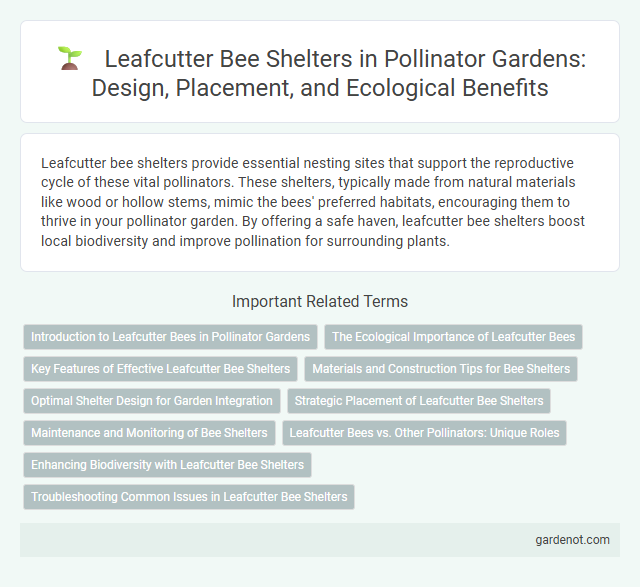Leafcutter bee shelters provide essential nesting sites that support the reproductive cycle of these vital pollinators. These shelters, typically made from natural materials like wood or hollow stems, mimic the bees' preferred habitats, encouraging them to thrive in your pollinator garden. By offering a safe haven, leafcutter bee shelters boost local biodiversity and improve pollination for surrounding plants.
Introduction to Leafcutter Bees in Pollinator Gardens
Leafcutter bees, renowned for their efficient pollination, are solitary bees that cut neat pieces of leaves to construct their nests in sheltered cavities. Incorporating a leafcutter bee shelter in pollinator gardens enhances biodiversity and supports plant health by increasing fruit and seed production. These bees prefer habitats with abundant flowering plants and protected nesting sites, making dedicated shelters essential for their population growth and ecosystem contribution.
The Ecological Importance of Leafcutter Bees
Leafcutter bees play a crucial role in pollination by efficiently transferring pollen while nesting in natural cavities or man-made shelters. Their unique behavior of cutting leaves to construct nest cells supports a diverse ecosystem by enhancing plant reproduction and biodiversity. Providing leafcutter bee shelters increases local pollinator populations, which is essential for maintaining healthy gardens and agricultural crops.
Key Features of Effective Leafcutter Bee Shelters
Effective leafcutter bee shelters boast natural materials like untreated wood or bamboo with perfectly sized holes ranging from 4 to 8 millimeters to accommodate nesting. These shelters provide protection from rain and predators by featuring overhangs or placement in sheltered locations. Proper ventilation and southern exposure optimize temperature and humidity, crucial for successful leafcutter bee reproduction and pollination efficiency.
Materials and Construction Tips for Bee Shelters
Leafcutter bee shelters are best constructed using untreated, natural wood with drilled holes ranging from 5 to 10 millimeters in diameter to mimic their preferred nesting sites. Bamboo tubes and hollow plant stems provide excellent alternative materials that support the bees' solitary nesting habits. Ensuring the shelter is placed in a warm, dry location facing south or southeast increases occupancy and protects the bees from predators and moisture.
Optimal Shelter Design for Garden Integration
Leafcutter bee shelters should incorporate natural materials such as untreated wood with smooth bore holes ranging from 4 to 8 millimeters in diameter to accommodate nesting preferences. Positioning the shelter in a sunny, sheltered location facing southeast enhances temperature regulation and protection from wind and rain. Integrating vertical structures or mounting the shelter at least 3 feet above ground level ensures accessibility for leafcutter bees while promoting effective garden pollination.
Strategic Placement of Leafcutter Bee Shelters
Strategic placement of leafcutter bee shelters in pollinator gardens maximizes nesting success by positioning them in sunny, south-facing locations protected from wind and rain. Placing shelters near pesticide-free flowering plants within 300 meters encourages foraging efficiency and supports local pollination. Elevated placements, around 3 to 5 feet above ground, reduce predator risks and optimize shelter temperature.
Maintenance and Monitoring of Bee Shelters
Regular maintenance of leafcutter bee shelters involves cleaning nesting tubes after each season to prevent disease and mold growth. Consistent monitoring ensures early detection of pests like parasitic wasps, which can damage bee larvae and reduce pollination efficiency. Replacing worn or damaged materials in the shelter improves habitat quality, supporting healthy populations of these vital pollinators.
Leafcutter Bees vs. Other Pollinators: Unique Roles
Leafcutter bees play a distinctive role in pollination by efficiently cutting leaves to build their nests, unlike honeybees and bumblebees that use wax or underground burrows. These solitary bees are crucial for pollinating alfalfa, squash, and various wildflowers, increasing biodiversity and crop yields. Providing leafcutter bee shelters supports their nesting behavior, promoting healthy ecosystems and enhancing pollination alongside other pollinator species.
Enhancing Biodiversity with Leafcutter Bee Shelters
Leafcutter bee shelters provide essential nesting habitats that increase local pollinator diversity and promote healthier ecosystems. These structures support the lifecycle of Megachile species, key pollinators for native plants and crops. Incorporating leafcutter bee shelters in pollinator gardens enhances biodiversity by fostering pollination services and sustaining balanced ecological networks.
Troubleshooting Common Issues in Leafcutter Bee Shelters
Leafcutter bee shelters often face issues such as moisture buildup, mold, and parasite infestations, which can harm bee populations. Ensuring proper ventilation and using natural materials like bamboo tubes or untreated wood can reduce moisture and discourage pests. Regular cleaning and relocating the shelter to a sunny, dry spot help maintain a healthy environment for leafcutter bees to thrive.
Leafcutter bee shelter Infographic

 gardenot.com
gardenot.com